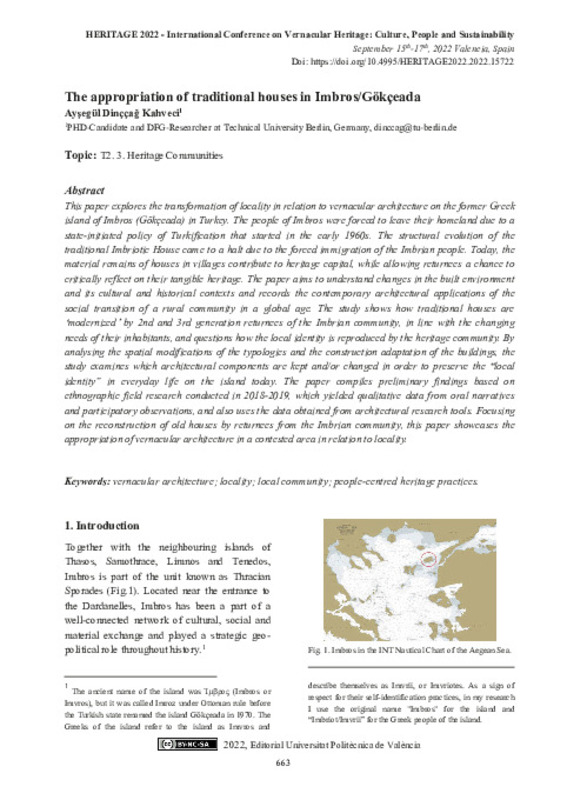JavaScript is disabled for your browser. Some features of this site may not work without it.
Buscar en RiuNet
Listar
Mi cuenta
Estadísticas
Ayuda RiuNet
Admin. UPV
The appropriation of traditional houses in Imbros/Gökçeada
Mostrar el registro sencillo del ítem
Ficheros en el ítem
| dc.contributor.author | Dinccag Kahveci, Aysegül
|
es_ES |
| dc.coverage.spatial | east=25.839555; north=40.1669236; name=Imbros/Gökçeada/Província de Çanakkale, Turquia | es_ES |
| dc.date.accessioned | 2022-11-07T10:55:01Z | |
| dc.date.available | 2022-11-07T10:55:01Z | |
| dc.date.issued | 2022-09-13 | |
| dc.identifier.isbn | 9788413960203 | |
| dc.identifier.uri | http://hdl.handle.net/10251/189244 | |
| dc.description.abstract | [EN] This paper explores the transformation of locality in relation to vernacular architecture on the former Greek island of Imbros (Gökçeada) in Turkey. The people of Imbros were forced to leave their homeland due to a state-initiated policy of Turkification that started in the early 1960s. The structural evolution of the traditional Imbriotic House came to a halt due to the forced immigration of the Imbrian people. Today, the material remains of houses in villages contribute to heritage capital, while allowing returnees a chance to critically reflect on their tangible heritage. The paper aims to understand changes in the built environment and its cultural and historical contexts and records the contemporary architectural applications of the social transition of a rural community in a global age. The study shows how traditional houses are ‘modernized’ by 2nd and 3rd generation returnees of the Imbrian community, in line with the changing needs of their inhabitants, and questions how the local identity is reproduced by the heritage community. By analysing the spatial modifications of the typologies and the construction adaptation of the buildings, the study examines which architectural components are kept and/or changed in order to preserve the “local identity” in everyday life on the island today. The paper compiles preliminary findings based on ethnographic field research conducted in 2018-2019, which yielded qualitative data from oral narratives and participatory observations, and also uses the data obtained from architectural research tools. Focusing on the reconstruction of old houses by returnees from the Imbrian community, this paper showcases the appropriation of vernacular architecture in a contested area in relation to locality. | es_ES |
| dc.format.extent | 7 | es_ES |
| dc.language | Inglés | es_ES |
| dc.publisher | Editorial Universitat Politècnica de València | es_ES |
| dc.relation.ispartof | Proceedings HERITAGE 2022 - International Conference on Vernacular Heritage: Culture, People and Sustainability | |
| dc.rights | Reconocimiento - No comercial - Compartir igual (by-nc-sa) | es_ES |
| dc.subject | Vernacular architecture | es_ES |
| dc.subject | Locality | es_ES |
| dc.subject | Local community | es_ES |
| dc.subject | People-centred heritage practices | es_ES |
| dc.title | The appropriation of traditional houses in Imbros/Gökçeada | es_ES |
| dc.type | Capítulo de libro | es_ES |
| dc.type | Comunicación en congreso | es_ES |
| dc.identifier.doi | 10.4995/HERITAGE2022.2022.15722 | |
| dc.rights.accessRights | Abierto | es_ES |
| dc.description.bibliographicCitation | Dinccag Kahveci, A. (2022). The appropriation of traditional houses in Imbros/Gökçeada. En Proceedings HERITAGE 2022 - International Conference on Vernacular Heritage: Culture, People and Sustainability. Editorial Universitat Politècnica de València. 663-669. https://doi.org/10.4995/HERITAGE2022.2022.15722 | es_ES |
| dc.description.accrualMethod | OCS | es_ES |
| dc.relation.conferencename | HERITAGE2022 International Conference on Vernacular Heritage: Culture, People and Sustainability | es_ES |
| dc.relation.conferencedate | Septiembre 15-17, 2022 | es_ES |
| dc.relation.conferenceplace | Valencia, España | es_ES |
| dc.relation.publisherversion | http://ocs.editorial.upv.es/index.php/HERITAGE/HERITAGE2022/paper/view/15722 | es_ES |
| dc.description.upvformatpinicio | 663 | es_ES |
| dc.description.upvformatpfin | 669 | es_ES |
| dc.type.version | info:eu-repo/semantics/publishedVersion | es_ES |
| dc.relation.pasarela | OCS\15722 | es_ES |








